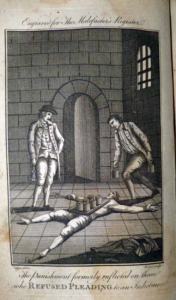Let’s begin with a bit of etymology ’cause that’s the way we roll. “Plea” and “please” come from the same Latin root, placere, meaning “to please.” Plea made its way into English via French, and by medieval times, plea meant “lawsuit.” The English had a complicated judicial system that included the Court of Common Pleas as well as the Exchequer of Pleas, and US states such as Pennsylvania and Ohio still have common pleas courts.
But eventually plea took on another meaning as well: a formal answer to criminal charges. That’s the kind of plea we’re discussing today.
The typical procedure in the US is for a defendant to enter a plea at some point during the legal proceedings. The precise point is going to depend on the jurisdiction and the severity of the charges. Whenever it occurs, the defendant has two (or possibly three) options:
- Guilty: This plea means the defendant admits to the charges. No trial is necessary. In practice, a guilty plea often occurs as a result of plea bargaining, during which the prosecutor agrees to reduce the initial charges and the defendant agrees to plead guilty to those reduced charges.
- Not guilty: This means the defendant denies part or all of the charges. Unless he changes his mind, a plea agreement is reached, or the prosecutor drops the charges, the case will go to trial.
- Nolo contendere: Also called no contest. This means the defendant does not admit to the charges–but she doesn’t deny them either. Why would this happen? Usually it’s the result of a plea bargain. The defendant’s still going to be punished the same as if she had pled guilty. The advantage from her standpoint is that a nolo contendere plea can’t usually be used as evidence against the defendant in any related civil lawsuits (but a guilty plea or a conviction can). Not all jurisdictions allow this plea.

Peine forte et dure.
At common law (i.e., in Merrie Olde England), a trial could not proceed until the defendant entered a plea. As you might imagine, this could cause problems when stubborn defendants kept their mouths shut. In those cases, English law allowed something called peine forte et dure (forceful and hard punishment) or, in English, pressing. The defendant would be tied down, a board would be put on him, and then weights or stones would be piled on the board until he either entered a plea—guilty or not guilty—or died. If he entered a plea, the weights would be removed and he’d go to trial. Some defendants chose to die instead. Why? Because if they went to trial, the consequences could be terrible for their family, including torture or forfeiture of property. But if the defendant was pressed to death, his family remained unscathed and got to keep his estate.
The English abolished pressing in the 18th century, as did Colonial America. Today, if someone stands mute (refuses to enter a plea), the court will automatically enter a plea of not guilty for them.
If a defendant enters a not-guilty plea, he can change it later on. This happens all the time during plea bargaining, and it’s strongly encouraged because it reduces costs and court backlogs. On the other hand, it’s much harder for a defendant to withdraw a guilty plea. It has to be allowed by the judge, who will do so only under certain circumstances, such as a strong proof that the defendant is actually innocent or evidence that the defendant didn’t understand what was happening.
The good news is that, no matter what, today’s defendants won’t be squished under weights.
Incidentally, just as defendants are limited in what pleas they can enter, juries are limited in what verdicts they can decide. Juries have only two options: guilty or not guilty. I’ll discuss that in a later post.
